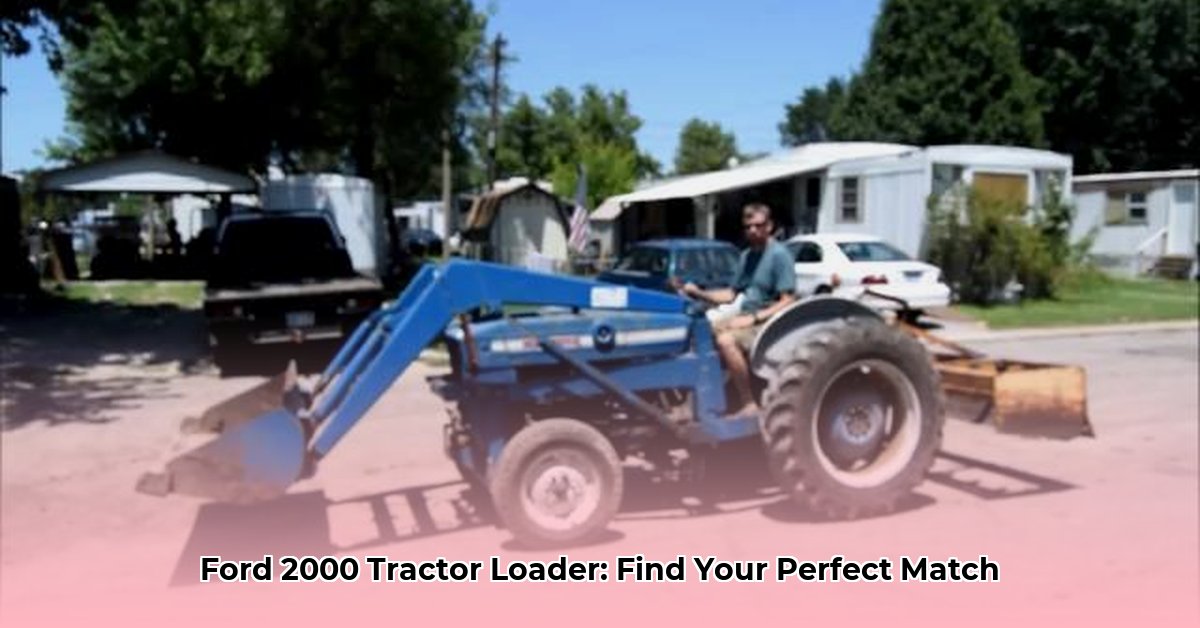
Adding a front-end loader to your Ford 2000 tractor significantly boosts its versatility. However, selecting and installing the right loader can be daunting. This guide provides a step-by-step approach, blending practical advice with safety considerations to empower you to make informed decisions. For similar Ford tractor loader information, check out this helpful guide on Ford 8N loaders.
Assessing Your Needs: Matching Loader to Task
Before embarking on your loader search, carefully assess your needs. What tasks will the loader perform? Hay bale handling? Light landscaping? Heavy-duty material moving? The answers will determine the necessary size and lifting capacity. Remember, exceeding the Ford 2000’s weight limits is dangerous. Prioritize safety! Consider your budget – used loaders offer cost-effective solutions. Don't forget to factor in the potential for adding counterweights to balance the loader's weight. This is a crucial aspect of safe operation.
Sourcing Your Loader: OEM vs. Aftermarket Options
Finding an original equipment manufacturer (OEM) loader for a Ford 2000 is incredibly difficult. Aftermarket loaders offer a more practical solution. Reputable brands like Superior and Freeman produce loaders compatible with the Ford 2000, although modifications might be required. Online marketplaces specializing in agricultural equipment and used equipment dealers are excellent resources.
Key Considerations:
| Feature | OEM Loader | Aftermarket Loader |
|---|---|---|
| Fit | Precise fit, factory-designed | May require adjustments or custom fabrication |
| Availability | Extremely scarce; high cost if found | Readily available; varied price points |
| Cost | Significantly higher | Generally more affordable |
| Warranty/Support | Limited manufacturer warranty, if any | Warranty and support vary by supplier |
Installation: A Detailed Approach
Installing a loader is a significant undertaking requiring precision and safety. Professional assistance might be necessary, especially for those lacking mechanical experience.
Step-by-Step Installation:
Hydraulic System Check: Thoroughly inspect your Ford 2000's hydraulic system. Ensure it's in optimal condition and capable of handling the added load. Upgrades may be necessary, depending on the loader’s specifications. A poorly functioning hydraulic system is a major safety hazard.
Mounting Bracket Assessment: The mounting brackets are critical. Aftermarket loaders often require adjustments or custom fabrication to ensure a secure fit. Precise measurements are paramount. Improper mounting can lead to instability and potential accidents.
Prioritizing Safety: Always disconnect the tractor's battery before commencing any work. This prevents accidental hydraulic activation. Securely support the tractor using jack stands. Wear appropriate safety gear (gloves, eye protection). A moment of caution can prevent serious injury.
Professional Help: If you encounter any uncertainty during installation, don't hesitate to seek help from a qualified mechanic or equipment specialist. A poorly installed loader is dangerous and costly to rectify.
Hydraulic System Deep Dive: Power Up vs. Gravity Down
Loaders utilize either power-up or gravity-down systems. Power-up systems use hydraulic pressure for both lifting and lowering, while gravity-down systems rely on gravity for lowering, with hydraulics only for lifting. The optimal choice depends on your preferences and your Ford 2000's hydraulic capabilities. Some loaders feature a hydraulic "trip" mechanism for added convenience and efficiency. Understanding these differences is vital for selecting the right loader.
Operation, Maintenance, and Troubleshooting
Safe operation is paramount. Never exceed the loader's weight capacity. Regular maintenance, including cleaning, lubrication, and fluid level checks, is essential for longevity and safety. Online forums dedicated to Ford 2000 tractors are invaluable resources for troubleshooting common issues. Develop a maintenance checklist to monitor your loader, preventing potential problems.
Safety Considerations: Risk Mitigation
Working with heavy machinery involves inherent risks. Adhere to all safety guidelines and relevant regulations. Document modifications and repairs meticulously. Regular inspections are crucial for preventing accidents, ensuring the longevity of equipment, and maintaining a safe working environment.
Remember: Careful planning, meticulous execution, and a staunch commitment to safety are essential for a successful loader installation and worry-free operation.